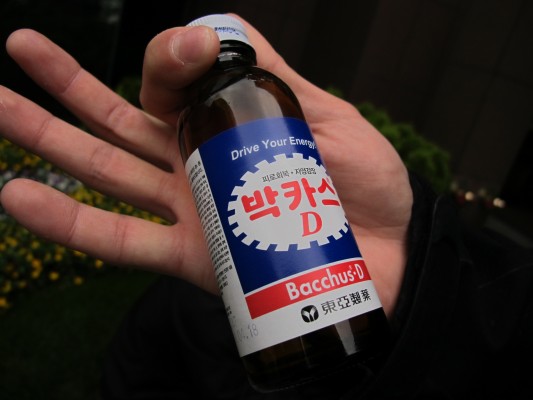 Most people have experienced those days when energy levels are staggeringly low, and a jolt of energy is absolutely necessary for a second wind. In these dire situations, people who live in the U.S. tend to turn to popular energy drinks like Red Bull, Monster, and jumbo sizes of Starbucks’ Doubleshot. Korea’s equivalent is Bacchus-D, and this was an important source of livelihood during long hours and late nights while filming Kimchi Chronicles. It was so insanely popular with cast and crew that we began buying it in bulk by the case!
Most people have experienced those days when energy levels are staggeringly low, and a jolt of energy is absolutely necessary for a second wind. In these dire situations, people who live in the U.S. tend to turn to popular energy drinks like Red Bull, Monster, and jumbo sizes of Starbucks’ Doubleshot. Korea’s equivalent is Bacchus-D, and this was an important source of livelihood during long hours and late nights while filming Kimchi Chronicles. It was so insanely popular with cast and crew that we began buying it in bulk by the case!
A potent combination of Korean ginseng, royal jelly, taurine, a vitamin B cocktail, and apple juice, Bacchus fans love it for its kitschy medicinal packaging and trademark hyper syrupy and citrus heavyy taste. It’s also differentiated from other energy drinks by its lack of carbonation. For those who enjoy the heady sensation of alcohol mixed with energy drinks, there is the popular “Bacchus Bomb”, an interesting take on a soju bomb that leads to serious bacchanalia. It’s also allegedly a good hangover cure, due to its super power ingredient, red ginseng. Clearly, its uses are multifaceted, and its touted for a slew of benefits, including improving physical performance, fighting fatigue, improving vision, and of course, maximizing energy! Talk about a miracle drink.
First launched in 1961, the name refers to Bacchus, the Greek god of wine and revelry. It was originally called Bacchus-F, with the F standing for Forte. In the 90’s, Bacchus-D was launched. The D refers to the amount of taurine in the new and improved version. With 2000 mg of taurine, Bacchus-D has double the amount of Bacchus-F, and the added bonus of less calories. It comes in an 100 mL bottle and 250 mL cans, and it packs a strong punch for its petite size. The smallest size has the same amount of taurine as a standard energy five times as large, at a fraction of the price.



